Möchten Sie 301-Weiterleitungen auf Ihrer WordPress-Website erstellen?
Wenn jemand Ihre Website über einen alten Link zu einer Seite besucht, die umgezogen ist, wird er mit einer 301-Weiterleitung automatisch auf die neue Seite weitergeleitet, so dass er keine 404-Fehlermeldung „Seite nicht gefunden“ erhält. Dies bietet ein besseres Nutzererlebnis und verbessert auch Ihre Keyword-Rankings.
In diesem Artikel zeigen wir Ihnen, wie Sie 301-Weiterleitungen in WordPress erstellen können.

Was ist ein Redirect in WordPress?
Eine Weiterleitung ist eine Möglichkeit für Ihre WordPress-Website, Nutzer automatisch an eine neue Adresse zu schicken, wenn die Seite, die sie besuchen möchten, verschoben oder ersetzt wurde. Dies ist vergleichbar mit der Art und Weise, wie ein Postamt Ihre Post weiterleitet, wenn Sie umziehen.
Es gibt verschiedene Arten von Weiterleitungen, die mit Nummern wie 301, 302 und 307 gekennzeichnet sind. Sie leiten den Webbrowser Ihres Nutzers automatisch auf eine andere URL weiter, wenn er versucht, eine Seite zu besuchen, die nicht existiert.
In diesem Leitfaden für Einsteiger werden wir uns auf 301-Weiterleitungen konzentrieren, da sie die wichtigste Art sind. Sie teilen dem Browser mit, dass die Seite dauerhaft an den neuen Ort verschoben wurde und dass Sie nicht beabsichtigen, sie zurück zu verschieben.
Werfen wir also einen Blick darauf, wann Sie eine 301-Weiterleitung verwenden sollten.
Wann brauchen Sie eine 301-Weiterleitung in WordPress?
Der Hauptgrund für die Verwendung einer 301-Weiterleitung ist, dass Ihre Website oder eine Seite auf Ihrer Website verschoben wurde und Sie den Benutzer stattdessen auf eine neue Seite verweisen möchten.
Sie wird auch benötigt, wenn Sie den Permalink eines Beitrags oder einer Seite ändern möchten.
Wenn Sie keine Weiterleitung einrichten, erhalten Ihre Nutzer eine 404-Fehlermeldung, wenn die Seite nicht gefunden wird. Dies führt zu einem schlechten Nutzererlebnis und kann sich auf die SEO Ihres WordPress-Systems auswirken.
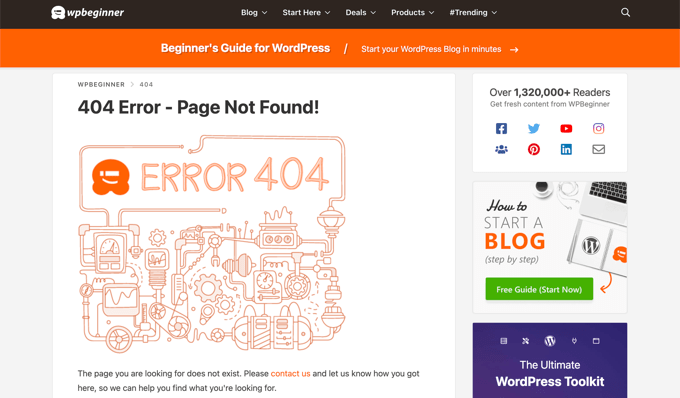
Sie können auch wertvolle Backlinks verlieren, wenn es auf Ihrer Website viele defekte Links gibt. Dies führt zu einem erheblichen Rückgang Ihrer Domain-Autorität und Ihrer Keyword-Rankings.
Aus diesem Grund sind 301-Weiterleitungen sehr wichtig. Sie ermöglichen es Ihnen, Suchmaschinen und Ihren Nutzern mitzuteilen, dass die Seite, die sie zu erreichen versuchen, dauerhaft an eine neue Stelle verschoben wurde.
Auf diese Weise werden der gesamte Verkehr und die Backlinks Ihrer alten Seite auf die neue Seite übertragen.
Schauen wir uns nun an, wie Sie 301-Weiterleitungen in WordPress erstellen können. Wir werden Ihnen zeigen, wie Sie das mit verschiedenen WordPress-Weiterleitungs-Plugins und manuell mit Code ganz einfach machen können.
Video-Anleitung
Wenn Sie eine schriftliche Anleitung bevorzugen, lesen Sie einfach weiter.
Methode 1: Erstellen von 301-Weiterleitungen mit dem AIOSEO Plugin
Der einfachste Weg zur Verwaltung und Erstellung von 301-Weiterleitungen ist das All in One SEO (AIOSEO) WordPress-Plugin. Es ist das beste SEO-Plugin für WordPress und wird von über 3 Millionen Fachleuten verwendet, um die SEO ihrer Website zu verbessern.
AIOSEO bietet einen leistungsstarken Redirection Manager, der es sehr einfach macht, defekte Links auf Ihrer Website zu finden und 301-Weiterleitungen einzurichten, um sie zu beheben.
Hinweis: Sie benötigen AIOSEO Pro, um den Redirection Manager zu nutzen. Es gibt auch eine kostenlose Version von AIOSEO, die jedoch keine 301-Weiterleitungen enthält.
Zunächst müssen Sie das AIOSEO Pro Plugin auf Ihrer Website installieren und konfigurieren. Weitere Informationen finden Sie in unserer Schritt-für-Schritt-Anleitung, wie Sie All in One SEO richtig einrichten.
Sobald das Plugin aktiviert ist, müssen Sie in Ihrem WordPress-Dashboard zu All in One SEO “ Redirects gehen und dann auf die Schaltfläche „Activate Redirects“ klicken.
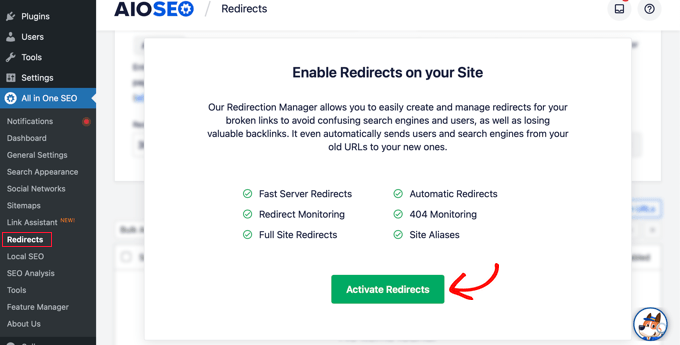
Als nächstes können Sie auf die Registerkarte „Einstellungen“ klicken und „PHP“ als Umleitungsmethode auswählen.
Dies ist die einfachste Methode zur Erstellung von Weiterleitungen und erfordert keine serverseitige Konfiguration.
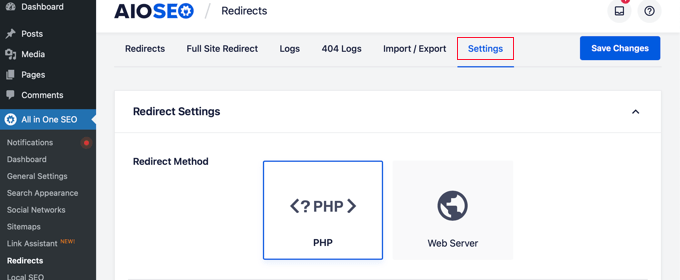
In AIOSEO können Sie auch die Umleitungsmethode für den Webserver auswählen. Dazu muss jedoch Apache oder NGINX auf Ihrem Webserver konfiguriert werden. Dies erfordert technische Kenntnisse und ist für Anfänger nicht zu empfehlen.
301-Umleitungen erstellen
Jetzt können Sie 301-Weiterleitungen erstellen. Gehen Sie dazu auf die Registerkarte „Weiterleitung“.
Zuerst müssen Sie den Link, den Sie umleiten möchten, in das Feld „Quell-URL“ eingeben. Danach sollten Sie das neue Ziel für den Link in das Feld „Ziel-URL“ eingeben.
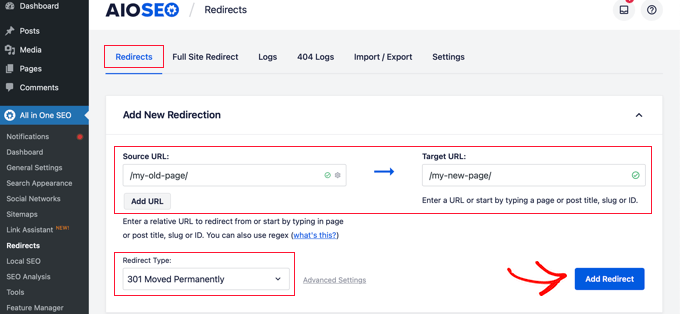
Vergewissern Sie sich nun, dass der Umleitungstyp „301 Moved Permanently“ lautet, und klicken Sie dann auf die Schaltfläche „Add Redirect“.
Wenn Sie mehrere URLs an einen neuen Ort umleiten möchten, klicken Sie einfach auf die Schaltfläche „URL hinzufügen“ unter dem Feld Quell-URLs.
Anschließend können Sie nach unten scrollen, um die Protokolle der von Ihnen erstellten Weiterleitungen anzuzeigen. In der Spalte „Hits“ wird die Anzahl der Personen angezeigt, die den umgeleiteten Link besucht haben, und es gibt eine Option zum Aktivieren oder Deaktivieren einzelner 301-Weiterleitungen.

Hinzufügen von 301-Umleitungen zur Behebung von 404-Fehlern
AIOSEO kann Ihnen auch helfen, 404-Fehlerseiten zu verfolgen und zu beheben.
Um diese Option zu aktivieren, müssen Sie auf der Registerkarte „Einstellungen“ zum Abschnitt „Umleitungsprotokolle“ scrollen. Aktivieren Sie dann die Optionen für „404 Logs“ und „Redirect Logs“.
Sie können auch den Zeitraum auswählen, in dem die Protokolle aufbewahrt werden sollen. Wir empfehlen, sie maximal einen Monat lang aufzubewahren, um eine reibungslose und schnelle Serverleistung zu gewährleisten.
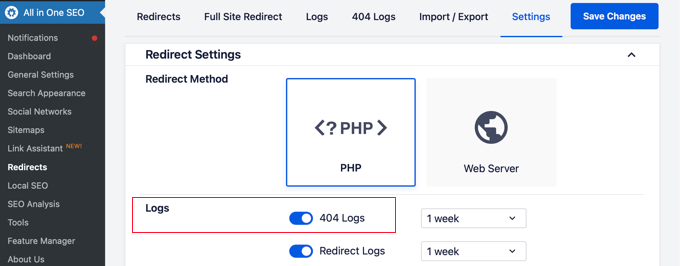
Nachdem Sie diese Optionen aktiviert haben, klicken Sie bitte auf die Schaltfläche „Änderungen speichern“.
Sie sollten nun eine neue Registerkarte ‚404 Logs‘ im Abschnitt Redirects sehen. Hier zeigt AIOSEO Ihre defekten Links an und ermöglicht es Ihnen, Umleitungen einzurichten. Außerdem sehen Sie unter „Hits“ die Anzahl der Besuche auf dem Link sowie das Datum und die Uhrzeit des letzten Zugriffs.
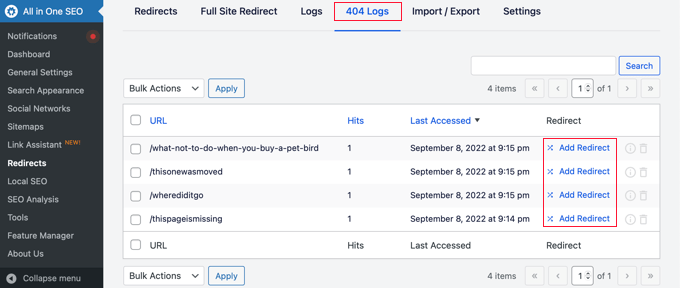
Hinweis: Sie werden keine Daten finden, wenn Sie die 404-Protokolle zum ersten Mal aktivieren. Das Plugin beginnt erst mit der Aufzeichnung von 404-Fehlerseiten, nachdem die Einstellung aktiviert wurde.
Klicken Sie dann auf den Link „Weiterleitung hinzufügen“ neben der 404-Fehler-URL, die Sie weiterleiten möchten. Dies ist nicht die Schaltfläche am unteren Rand.
Sie haben nun die Möglichkeit, eine Ziel-URL einzugeben und den Umleitungstyp aus dem Dropdown-Menü auszuwählen.

Geben Sie Ihre neue URL ein und wählen Sie „301 Moved Permanently“ als Umleitungstyp. Klicken Sie nun auf die Schaltfläche „Weiterleitung hinzufügen“.
AIOSEO wird nun eine 301-Weiterleitung für Ihren defekten Link erstellen. Um zu sehen, ob die Weiterleitung richtig funktioniert, besuchen Sie einfach die alte URL und prüfen Sie, ob Sie zum neuen Ziel geleitet werden.
Hinzufügen von 301-Umleitungen direkt von einem Beitrag oder einer Seite
AIOSEO ermöglicht es Ihnen auch, einen veröffentlichten Beitrag oder eine Seite umzuleiten, während Sie ihn/sie bearbeiten.
Wenn Sie im WordPress-Editor zum unteren Ende der Seite scrollen, finden Sie einen Abschnitt AIOSEO-Einstellungen. Dort müssen Sie auf die Registerkarte „Weiterleitungen“ klicken.
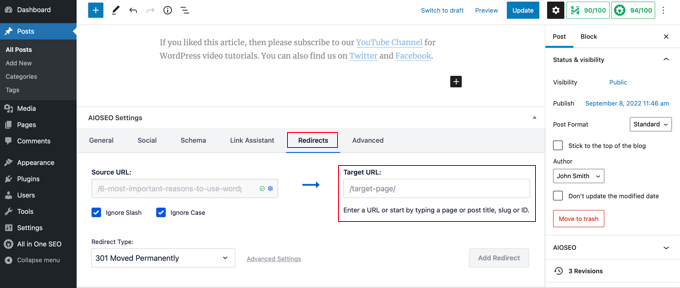
Die Quell-URL wurde bereits für Sie ausgefüllt. Geben Sie einfach die neue URL in das Feld „Ziel-URL“ ein und wählen Sie „301 Moved Permanently“ aus dem Dropdown-Menü Redirect Type.
Wenn Sie den Permalink eines Beitrags während der Bearbeitung ändern, bietet AIOSEO an, die alte URL auf die neue umzuleiten.
In beiden Fällen klicken Sie auf die Schaltfläche „Umleitung hinzufügen“, und schon sind Sie fertig.
Umleitung vollständiger Websites
Wenn Sie Ihre Website auf einen neuen Domänennamen umziehen, können Ihre Besucher auf fehlerhafte Links stoßen, und die Suchmaschinenoptimierung Ihrer Website kann darunter leiden.
Mit AIOSEO können Sie Ihre gesamte Website an einen neuen Standort verschieben, ohne Traffic oder Suchmaschinenplatzierungen zu verlieren. Dies ist eine 301-Weiterleitung für die gesamte Website.
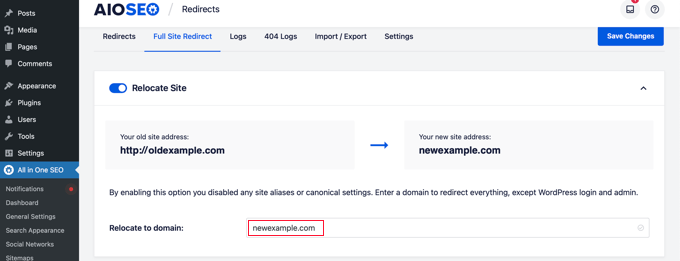
Es ist wichtig, dass Sie dies auf die richtige Art und Weise tun, daher haben wir eine Schritt-für-Schritt-Anleitung für Anfänger erstellt, wie man eine vollständige Website-Weiterleitung mit WordPress durchführt.
Methode 2: Erstellen von 301-Umleitungen mit dem Umleitungs-Plugin
Eine weitere Möglichkeit, Weiterleitungen in WordPress hinzuzufügen und zu verwalten, ist das Redirection-Plugin.
Zunächst müssen Sie das Plugin installieren und aktivieren. Sie können unserer detaillierten Anleitung zur Installation eines WordPress-Plugins folgen.
Hinweis: Die Einrichtung von 301-Weiterleitungen mit einem WordPress-Plugin ist zwar einfach, hat aber einige kleinere Leistungseinbußen. Abhängig von Ihrem WordPress-Hosting-Anbieter können Ihre Weiterleitungen ein paar Mikrosekunden langsamer sein als andere Methoden.
Wenn Sie Ihre Weiterleitungen so schnell wie möglich machen wollen, dann können Sie dies tun, indem Sie Ihre .htaccess-Datei mit der unten stehenden Methode 5 bearbeiten.
Nach der Aktivierung gehen Sie auf Tools “ Redirection und klicken Sie auf die Schaltfläche „Start Setup“.
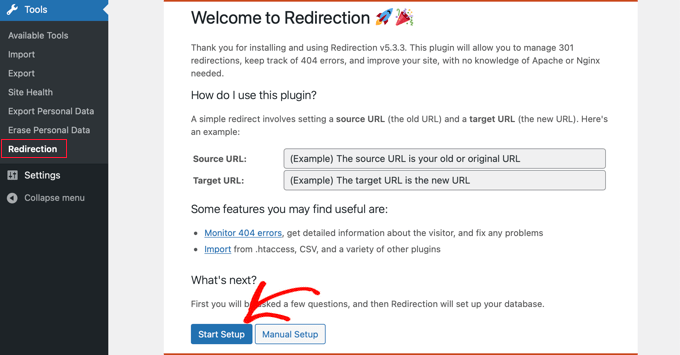
Als Nächstes können Sie Optionen zur Überwachung von Permalink-Änderungen in WordPress auswählen und ein Protokoll aller Weiterleitungen und 404-Fehler führen.
Sie können diese Optionen einfach aktivieren und auf die Schaltfläche „Einrichtung fortsetzen“ klicken.
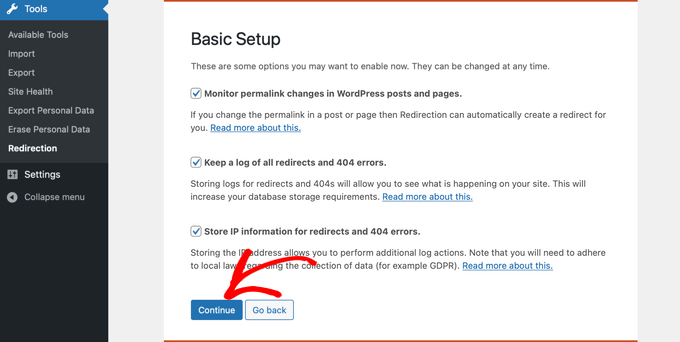
Das Plugin wird nun automatisch die Rest-API testen.
Wenn der Status „Gut“ angezeigt wird, klicken Sie auf die Schaltfläche „Einrichtung beenden“.
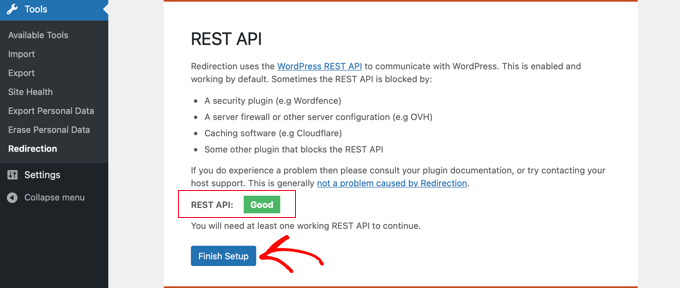
Das Umleitungs-Plugin führt noch einige Aufgaben aus, um seine Einrichtung abzuschließen. Wenn der Fortschrittsbalken 100 % erreicht hat, können Sie auf die Schaltfläche „Weiter“ und dann auf die Schaltfläche „Bereit zum Starten“ klicken.
Das Plugin ist nun bereit für die Erstellung Ihrer 301-Weiterleitungen. Um damit zu beginnen, gehen Sie in Ihrem WordPress-Panel zum Abschnitt Tools “ Umleitung. Sie sollten den Abschnitt „Neue Weiterleitung hinzufügen“ am unteren Rand des Bildschirms sehen.
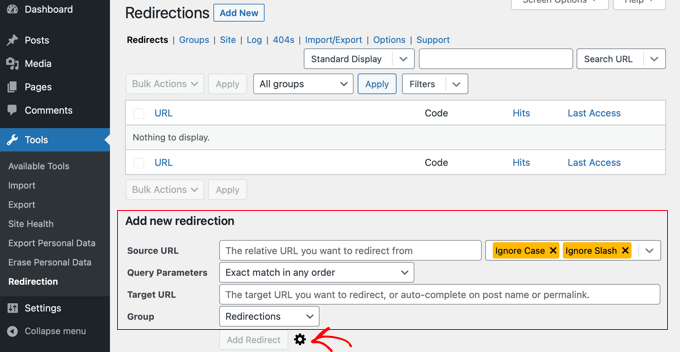
Sie sehen die Grundeinstellungen zum Hinzufügen einer Umleitung. Wenn Sie jedoch auf das Zahnrad-Symbol klicken, sehen Sie weitere Optionen zur Auswahl des Umleitungstyps.
Geben Sie einfach die Quell-URL Ihrer alten Seite ein und fügen Sie die „Ziel-URL“ hinzu, zu der Sie umgeleitet werden möchten. Stellen Sie außerdem sicher, dass die HTTP-Code-Option auf „301 – Dauerhaft verschoben“ eingestellt ist.

Sobald Sie alle Details eingegeben haben, klicken Sie auf die Schaltfläche „Weiterleitung hinzufügen“.
Methode 3: Erstellen von 301-Umleitungen mit dem Simple 301 Redirects Plugin
Eine der einfachsten Möglichkeiten, 301-Weiterleitungen zu erstellen, ist das Simple 301 Redirects Plugin. Wie der Name schon sagt, macht es 301-Weiterleitungen wirklich einfach.
Zu Beginn müssen Sie das Plugin auf Ihrer Website installieren und aktivieren.
Danach müssen Sie Einstellungen “ 301 Weiterleitungen aufrufen. Hier können Sie die alte URL in das Feld „Anfrage“ und Ihre Ziel-URL in das Feld „Ziel“ eingeben.

Klicken Sie anschließend auf die Schaltfläche „Neu hinzufügen“, um die 301-Weiterleitung zu erstellen. Das war’s.
Einfache 301-Umleitungen funktionieren ab sofort.
Methode 4: Vorhandene Seiten mit Seitenlinks zum Plugin umleiten
Es kann vorkommen, dass Sie einen Beitrag im Feed Ihrer Website oder eine Seite auf eine bestimmte Art und Weise auf Ihrer Website aufführen möchten, der Inhalt aber woanders gehostet wird. Hier kommt das Plugin Page Links To ins Spiel.
Sobald Sie das Plugin installiert und aktiviert haben, fügt es Ihrem WordPress-Editor ein Metafeld hinzu. Hier können Sie die Adresse des neuen Standorts eingeben, an den Sie Ihre Nutzer schicken möchten.
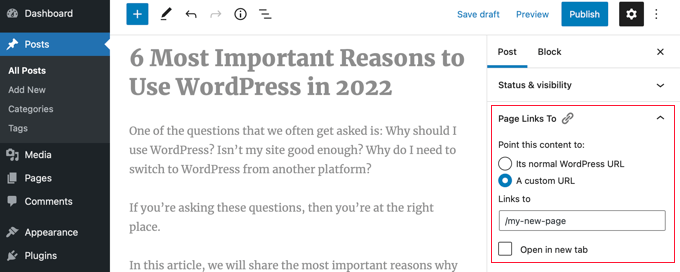
Wenn Sie auf „Aktualisieren“ oder „Veröffentlichen“ klicken, behandelt WordPress den Beitrag oder die Seite ganz normal, aber wenn jemand den Beitrag oder die Seite besucht, wird er/sie stattdessen an die von Ihnen gewählte benutzerdefinierte URL weitergeleitet.
Sie könnten zum Beispiel einen Blog haben, in dem Sie gelegentlich herunterladbare Inhalte erstellen, aber Sie möchten, dass die Nutzer Ihres Online-Shops bestimmte Beiträge als Produkte sehen. Mit diesem Plugin können Sie das tun, ohne Abstrafungen für doppelte Inhalte durch Google zu riskieren oder Ihre Nutzerbasis zu spalten.
Methode 5: Manuelle Erstellung von 301-Umleitungen mit .htaccess
WordPress-Nutzer können auch 301-Weiterleitungen einrichten, indem sie die .htaccess-Konfigurationsdatei des Webservers bearbeiten.
Bitte denken Sie daran, dass ein kleiner Fehler in Ihrem .htaccess-Code dazu führen kann, dass Ihre WordPress-Website nicht mehr zugänglich ist und einen Internal Server Error anzeigt.
Deshalb ist es wichtig, dass Sie eine Sicherungskopie Ihrer .htaccess-Datei erstellen, bevor Sie irgendwelche Änderungen vornehmen.
Bearbeiten Sie Ihre .htaccess-Datei mit dem All in One SEO Plugin
Wenn Sie das All in One SEO-Plugin installiert haben, können Sie Ihre .htaccess-Datei einfach bearbeiten.
Hinweis: Sie benötigen All in One SEO Pro, um den .htaccess-Editor zu verwenden.
Besuchen Sie einfach die Seite All in One SEO “ Tools und wechseln Sie zur Registerkarte „.htaccess Editor“.
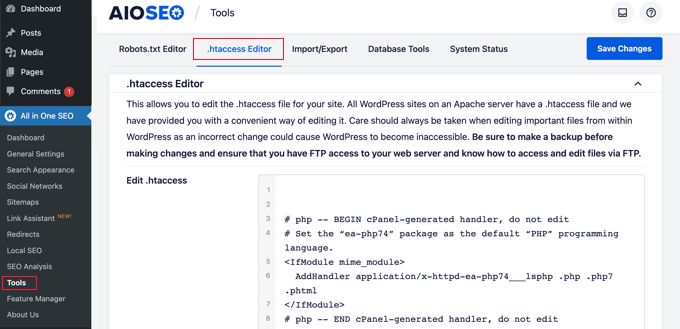
Von hier aus sehen Sie den Inhalt Ihrer .htaccess-Datei im Editor. Sie können den Umleitungscode, den Sie hinzufügen möchten, einfach am Ende der Zeile „# END WordPress“ einfügen.
Hier ist eine einfache Umleitung, bei der wir versuchen, einen Benutzer, der einen alten Beitrag besucht, zu einem neuen Beitrag weiterzuleiten.
RewriteEngine On
Redirect 301 /a-very-old-post/ http://yoursite.com/a-very-new-post/
Vergessen Sie nicht, die URLs des alten und des neuen Beitrags zu ändern. Wenn Sie fertig sind, klicken Sie auf die Schaltfläche „Änderungen speichern“, um Ihre Einstellungen zu speichern, und All in One SEO wird Ihre .htaccess-Datei aktualisieren.
Direktes Bearbeiten der WordPress-.htaccess-Datei
Sie können Ihre WordPress .htaccess-Datei auch direkt bearbeiten, um Weiterleitungen einzurichten.
Um Ihre .htaccess-Datei zu bearbeiten, müssen Sie mit einem FTP-Client eine Verbindung zu Ihrer Website herstellen. Die .htaccess-Datei befindet sich im Stammverzeichnis Ihrer WordPress-Website.
Wenn Sie Ihre .htaccess-Datei nicht sehen können, lesen Sie unsere Anleitung, warum Sie die .htaccess-Datei auf Ihrer WordPress-Website nicht finden können.
Sie können .htaccess auf Ihren Computer herunterladen und mit einem Texteditor wie Notepad bearbeiten.
Sie können diesen Umleitungscode unten verwenden, um einen Benutzer, der einen alten Beitrag besucht, zu einem neuen Beitrag weiterzuleiten. Sie sollten den Code am Ende Ihrer .htaccess-Datei nach der Zeile „# END WordPress“ einfügen.
RewriteEngine On
Redirect 301 /a-very-old-post/ http://yoursite.com/a-very-new-post/
Stellen Sie sicher, dass Sie die URLs des alten und des neuen Beitrags ändern. Danach können Sie Ihre Änderungen speichern und die .htaccess-Datei wieder auf den Server hochladen.
Jetzt können Sie Ihre Weiterleitung testen, um sicherzustellen, dass sie wie gewünscht funktioniert.
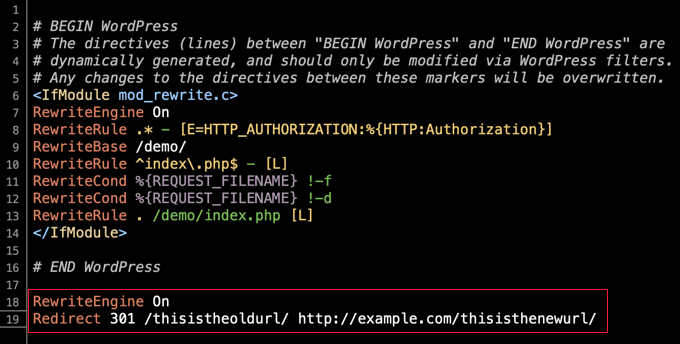
Darüber hinaus können Sie Ihre .htaccess-Datei auch über das Dashboard und den integrierten Dateimanager Ihres Hosting-Providers aufrufen und bearbeiten.
Sie finden Ihre .htaccess beispielsweise im Dateimanager von SiteGround, indem Sie auf Site Tools „ Site „ File Manager gehen und zum Ordner /public_html/ Ihrer Website navigieren.
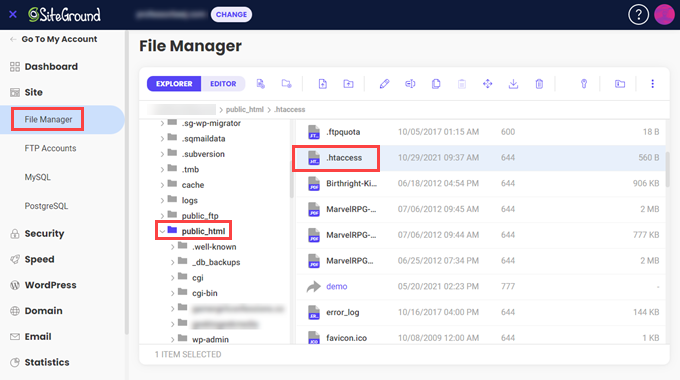
Dann können Sie mit der rechten Maustaste auf die .htaccess-Datei klicken und „Bearbeiten“ wählen.
Fügen Sie einfach den 301-Weiterleitungscode direkt ein und speichern Sie die Datei. Auch hier sollten Sie zur Sicherheit die ursprüngliche .htaccess-Datei als Backup herunterladen.
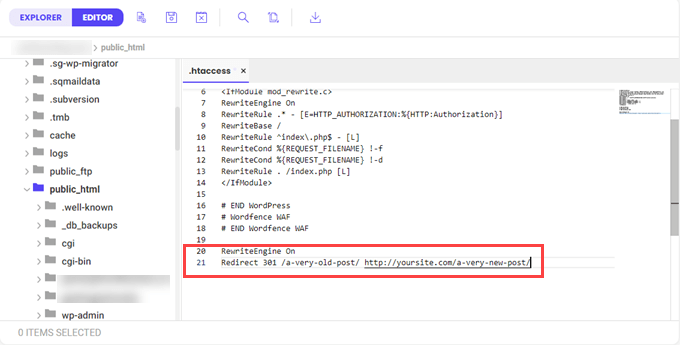
Wir hoffen, dass dieser Leitfaden für Anfänger zum Erstellen von WordPress-Weiterleitungen Ihnen beim Einrichten von Weiterleitungen auf Ihrer Website geholfen hat. Vielleicht interessieren Sie sich auch für unseren Leitfaden zum richtigen Start eines WordPress-Blogs oder für unsere Expertenauswahl der besten E-Mail-Marketingdienste für kleine Unternehmen.
Wenn Ihnen dieser Artikel gefallen hat, dann abonnieren Sie bitte unseren YouTube-Kanal für WordPress-Videotutorials. Sie können uns auch auf Twitter und Facebook finden.





Syed Balkhi says
Hey WPBeginner readers,
Did you know you can win exciting prizes by commenting on WPBeginner?
Every month, our top blog commenters will win HUGE rewards, including premium WordPress plugin licenses and cash prizes.
You can get more details about the contest from here.
Start sharing your thoughts below to stand a chance to win!
Laura says
Hi
Is it possible to make a redirect from the wix platform to wordpress?
WPBeginner Support says
Hi Laura,
Please see our guide on moving Wix to WordPress.
Admin
Hafiz Mateen Afzal says
Which plugin is best to create referrel links like:
Thanks
WPBeginner Support says
Hi Hafiz,
Thirsty Affiliates is the best way to manage your affiliate/referral links. Please see our guide on how to cloak affiliate links in WordPress.
Admin
cipriana leme says
How do I redirect from a wordpress blog (free) to a .com blog? I cannot install plugins in the free blog, so how could I do the redirect? Any advice?
Thanks in advance
Hannah says
Hello! I just created a website on WordPress.org and imported all of my content from my old site, example.wordpress.com (using WordPress.com). Is there a way to redirect all of the content from that site to my new one? The redirect instructions provided by WordPress gave me an error that the domain already exists, probably because it thought I was trying to create a new domain on WordPress.com.
My website traffic before is pretty minimal, so if anyone clicks on previous blog posts on my social channels, they’d be taken to the shut down version of my old site without the redirects – not the end of the world because I don’t have the following that would generate clicks at a later date, but you never know?
Any advice anyone has would be great!
Thanks,
Hannah
Senith Nal says
your lesson is very helpful. i like it.
Shakoat Hossain says
Brilliant solution to reduce redirects for worpress!
For a few days, I’m looking to solve my WP redirects issues. I don’t find out better solution even read this content.
Here, I got few good points and try to reduce redirect to increase my page load speed.
Thanks!
Roshni Kanchan says
Hello,
Please can you tell me – in the simple 301 redirect in the request URL column does wordpress / plugin take it as starting from http or https? Form where does it pick up this value?
Thanks for the article. It was useful. However the redirects using 301 redirect plugin is not working and landing on ‚Page does not exist‘ page.
WPBeginner Support says
Hi Roshni,
It uses your WordPress Site Address as defined in WordPress Settings > General page.
Admin
Nalin says
Hi,
If I want to change the url structure of my posts, even then redirection is necessary? Isn’t that already taken care of in WP?
Also if I don’t redirect, will it be harmful for seo or search engines can figure out WP’s automatic redirection?
Melissa says
Very helpful. Thank you for the tip. Thank you for making it so simple.
Melissa
Walter A. says
Thanks so much, I would’ve spent so much time doing it the long way. So happy Redirection worked instantly after install.
Cristian Adam says
Hi Wpbeginner, I have a question about 301 permanent redirect and your advice will be great. I have an website about snoring and on that website are 2 related articles, 1 of them ranks for a lot of kws position 2-10 ( article A) and the other one just for 4-5 kws position 1-3 (article B). Both articles are on first google page and I want to permanent redirect the article B to A. Also on my website are some articles that point to article B and I want them to point to article A using same anchor texts. Now my question: Does this changes will pass the juice to article B to A and it will increase the article A rankings? And if I do this changes should I delete article B and reuse the content on other websites? Thank you very much for your time I will wait your answer, please excuse my bad english.
WPBeginner Support says
Hi Christian,
A 301 redirect will pass the link juice to new article. However, other search ranking factors would also apply to the new article, like relevance, context, keyword density, and more. Search engines may not find it relevant for the old keywords.
Admin
Raj says
Hi WP beginner team,
A quick question.
Last year, when we changed URLs, WordPress was automatically redirecting Old urls to new urls.
But after a recent wordpress core update, the automatic redirection is not happening.
Would you be able to explain? Or am I missing anything
Adebowale Adewale says
I am changing the domain of a wordpress website example.com to example.com.ng . I tried several 301 redirect rules in .htaccess , only the homepage redirects.
Please, assist me on the right code.
I have tried each seperately :
# BEGIN WordPress RewriteEngine On RewriteCond %{HTTP_HOST} ^www.example.com RewriteRule (.*) http://www.example.com.ng/$1 [R=301,L] # END WordPressand
RewriteEngine on RewriteCond %{HTTP_HOST} ^example.com [NC,OR] RewriteCond %{HTTP_HOST} ^www.example.com [NC] RewriteRule ^(.*)$ http://example.com.ng/$1 [L,R=301,NC]None is working for me.
Adebowale Adewale says
Thank you so much! I am very grateful.
Shubham Davey says
Do I need to own the domain while redirecting? My Domain is getting expired on 31st July and I will be redirecting to a new domain. So while it is redirected do I need to own the domain after 31st?
WPBeginner Support says
Hey Shubham,
Yes, you will need that domain for your redirects to continue working.
Admin
christian says
I have over 850 old post which I recently deleted on my site due to some reasons. I want to ask if there is an easy and automated way to redirect all the old post to just one post. The methods you listed are easy to do if you are trying to redirect 1 or 2 posts. pls, help me. Your reply is important.
christian says
Is my question not also important? pls, your reply will be very appreciated. I need this.
Haitham Alnaqeb says
You can try the permanent redirection methods from the cPanel. You can redirect all your 404 error into particular page.
Harmony A-E says
Can I redirect my wp-login to a 401 (unauthorized) page using this plugin?
Ahu says
Hi, this is a very helpful post thank you, but it seems like the instructions are for redirects from WP to WP.
I am moving my website from WordPress to New Kajabi platform.
I have around 250 post/pages in WP to 301 redirect to my new kajabi site.
My domain name will be the same but the url structures and names of the posts/pages will be different.
Would the tools you recommend still work in my case? If yes, how?
I would appreciate your urgent reply, Thank you
Ahu
Zoltan says
One thing I’m not clear about. Actually 2 things. 1 – Do I do the redirect on my new site or my old site. 2 – Where do I get a full list of my web pages from the old site?
Lokesh thota says
Hi. I have a WordPress website with 100 posts. But most of the backlinks are to the post rather than to the homepage. Does any of the methods above redirect all the posts to the new URL also. I want a 301 redirect to my new domain from only one URL.not all the 90 URLs.but at the same time I don’t want to lose link juice from those posts. Please specify a way to first redirect all the old posts to old homepage then redirect the old homepage to new URL.
Ado says
Hi, thanks for this info, very helpful.
So I decided to use the Simple 301 Redirects plugin… but did something REALLY dumb….
My wordpress site is still located in a subdirectory, with the Site address set to the main url (so WordPress Address URL is http://example.com/dev2017 and Site Address URL is http://example.com and .htaccess file updated)
There were some google search results showing the subdirectory address, so I installed the plugin and set a redirect with a wildcard for the subdirectory (obviously wasn’t thinking very well) and so now I can’t get in to the WP admin (as it’s in the subdirectory!!)
Is there a way to undo the redirects somehow? If I uninstall the plugin via FTP is it going to break the website???
Silly me….
WPBeginner Support says
Hey Ado,
First you need to deactivate plugin. After that you need to delete the .htaccess file in your site’s root folder. You will be able to login to your WordPress site. Once logged in you will need to regenerate .htaccess file. Simply visit Settings » Permalinks and then click on the save changes button without changing anything.
Admin
Fumio Mori says
can i use request url with variable?
Jennifer says
Could not have been easier! Thank you
Philemon O'Arpelleh says
Please, I changed the permalink of my WordPress site from
http://www.example.com/blog/%postname%tohttp://www.example.com/articles/%category%/%postname%and ALL my previous posts are affected.Please help me on how to setup a onetime redirection for ALL posts.
Thank you.
WPBeginner Support says
Hey Philemon,
You can do that by visiting the permalinks page under settings.
Admin
Mark says
What is the best way to redirct adress like that: mywbsite.com/wp-content/uploads/2008/12/mybook.pdf to normal web page. Tha it not normal wordpress page or post but is ranking on some keywoords and i would like to redirect to specyfic wordpres page. WHAT metod redirection should i use ? In that case simple 301 edirect plugin not work for me.
thanks
Chrissy says
I have what may be a silly question. I have a site that is not a WordPress site (it’s using Shopify right now) and I am recreating the site on a new URL in WordPress. Will the redirect plugins still work to direct the old (Shopify) links to the New (WordPress) ones?
WPBeginner Support says
Hey Chrissy,
WordPress plugins will be installed on your WordPress site. They can redirect users to correct post/page/product once the user reaches your website. You will have to redirect Shopify visitors to your WordPress site, and then redirect plugins take it from there.
Admin
Thom Duncan says
I’m able to create a redirect using the Redirection plug-in, but with this problem:
/old/ to /new/ works fine, but
/old to /new/ picks up pages that I do not want to redirect, such as
/old-2016 which then points to the non-existent /new/-2016.
Charles D. Shell says
I have an annoying problem. My site had the default settings for the blog posts, so I set up redirects and changed it to the %postname% option. Unfortunately, when I do that, my home (blog) page disappears. I’ve been chasing this problem for a while. Do you have a video with a solution? Or at least a way to point me in the right direction?
Ana says
I don’t know if I understand your problem but my suggestion is not to redirect the url (using plugins or at the .htacess). You need to change de permalinks structure at the WP configuration. Somthing like this: https://www.wpbeginner.com/plugins/how-to-change-custom-post-type-permalinks-in-wordpress/
I hope I could help.
Sorry about my english
Charles D. Shell says
When I change the permalink structure on the dashboard to %postname%, my home page http://charlesdshell.com/blog/ disappears. Or rather all blog posts and widgets disappear. All that’s left is a 404 error message.
All the redirects on all the pages work fine, but I can’t seem to get the home page to stick around.
Yeshna says
I want to redirect my site form wordpress.com to wordpress.org. Is there any other way to redirect for free?
By the way,are those plugins free?
WPBeginner Support says
Hi Yeshna,
Unfortunately, you will have purchase the redirect service from WordPress.com to redirect your old WordPress.com blog traffic to your new WordPress.org blog.
Admin
Steve says
I want to redirect my current live wordpress site (hosted by Hostgator) to a new domain name that I just bought from Godaddy. My questions are: 1) does my new domain name need to be hosted by HG in order to have my live site redirect to the new domain name. 2) does the new domain site need to have content already?
Thank you for your help.
Aleen says
Is there a way to do bulk redirects with one of these plugins? I want to update my permalinks to exclude the date, but don’t want to have to manually redirect 200+ posts. Please help!
Also, thanks for all of your great articles. You are great at putting them in non-technical terms.
nelson says
i want to know if this could be done. have a user that had a site working, after i installed wordpress they wanted to change to wordpress so i created them a space and a site that calls wordpress/newsite.
now i want:
when typing my.old.url/site the information that comes out should be worpress/newsite
could this be possible whith the redirect.
Aslam Khan says
I have deleted some of my posts from my website earlier.
Now, I am getting not found errors for those pages as expected.
I tried to redirect old URLs using a method provided by my hosting provider. But those redirects are not working.
I want to ask, if I use .htaccess redirects and keep previous redirects setup on hosting provider, can it cause any problems?
I need expert advice.
Laura says
Ok, I am not sure why the .htaccess method is not working for me. I would like to avoid installing any more plugins on the client’s site. They have too many already for my liking. I’ve used your instructions because what I’ve used for redirect in the past didn’t seem to be working on her site for some reason. But this isn’t either. Not sure what the problem is. Have you run into this before? I’ve flushed the Permalinks, but am still getting a 404 when I try to go to the old URL I’ve rewritten.
Martin says
I am having the ame problem here. It’s still not redirecting.
Rhys Clay says
@Aslam & @Laura,
One little got ya with 301’s and wordpress via the .htaccess file is that you need to place your redirects between:
RewriteEngine On
And:
RewriteBase /
This is because wordpress has its own mods to the htaccess file to apply and changes the RewriteBase setting which I think causes problems with regular ol 301 redirects on shared hosting.
Mauro says
Now how wpbeginner chooses to do redirection on the site? .htaccess, Redirections plugins, or what?
Thanks,
Jagdeep Singh says
I installed this plugin it’s coming under „Setting“ tab rather than „Tool“ option.
Mike says
Thank you very much for the tip on 301 Redirects plugin, works like a charm!
Sumit says
I think in wordpress, there is no need to set redirection when changing slug of the post. It is done automatically. Right ?
Laura says
If someone has bookmarked the old URL, for instance, or if the search engines have indexed the old URL and are still serving it in search results, you need to have a redirect in place so you aren’t losing traffic.
Allahlea says
I research everywhere and I want to confirm what I learned.
I want to redirect my site form wordpress.com to wordpress.org. There is no other way to redirect but to pay for site redirect. Right? Is there any other option?
If there is no other way, can I redirect every single post for free? if there is HOW?
Kelly says
ALLAHLEA, did you find an answer to this question? I want to know the same thing.
SK says
Thank you very much. You saved my day. I need this post to redirect all my old posts to new posts. I have a question though. I just forwarded the old post to the new updated post, but I didn’t delete the old post contents. My old and new post have the same contents, but I redirected the old post to new post. Should I delete the contents of the old article to avoid plagiarism issues? Does it affect my SEO? Thanks again for this valuable post.
WPBeginner Support says
No it is alright. Search engines understand that site-owners may want to redirect URLs for other reasons too.
Admin
Aditya Mankad says
How I can have a redirect on a free wordpress account. I am pretty sure I cannot add a plug-in.
Is it possible or if not; another way to redirect the users to my new page (which is NOT a free hosting)
P.S gave the info about the new site as not free hosting because maybe something can be done about it.
WPBeginner Support says
Please see our guide on how to properly move from WordPress.com to self hosted WordPress.org site.
Admin
Danny Flood says
Thanks for this, but nothing is working for me. I have tried 3 different plugins – Quick Page / Post Redirect, Simple 301 Redirects, and Redirection. The only thing they are able to accomplish is redirect me when I am logged in to WP-Admin. For non-logged in users, the redirect does not work. How do I fix this?
Jim says
I changed a TAG name.
How can I use your .htaccess solution to redirect old-tag to new-tag?
Is that possible?
Thx!
Anand says
Oops…my comment, which was actually a question, doesn’t seem to have struck well with you.
It’s alright if you don’t have an answer. It just means, you need to work more & better.
Thanks anyway
WPBeginner Support says
We answered your comment. sorry for the delay.
sorry for the delay.
Admin
Anand says
Hi,
Thanks for introducing the redirection plugins.
Using the ‚redirection‘ pluginsis it possible to add bulk redirects?
The case in point is change in domain name, where you would want to redirect all pages from old domain to new domain. Adding redirects one by one for each page doesn’t sound like a good solution.
Appreciate you help please.
WPBeginner Support says
Yes, it is possible.
Admin
Johnny says
WOW! Thank you!
Denika says
When using the coding way to get a redirect, do you need to include RewriteEngine On for each redirect? Or do you include it once and just follow through with each redirect on it’s own line?
nina says
So, do we keep google search positions with redirects, lets say my posts i want to redirect are on the first page of google What happens after redirect? Thanks, hoping for an answer.
WPBeginner Support says
If you are doing a 301 redirect, then Google will consider replacing your new url with the old one. However, the position of that page in search results will depend on whatever content it has. For example, if your old page was about „apples“ and your new page is about „oranges“ then it will certainly not appear for apples related keywords anymore.
Admin
Nina says
Thanks, i have one more question. I forgot to tell you i want to redirect some posts from blog A, to new blog B. I can still use these techniques? I have to copy paste old content to new post on blog B then am i right ? I want content to stay the same, only want it to be shown on blog B instead of blog A. In this case google also keeps rankings or not?
Thanks a lot again:)!
Raghu koorthy says
Can you pls run a article on how to create a landing page or squeeze page and link it to mail chimp. Thank you.
Raghu Koorthy says
Simple but very useful information.
I started working with WP recently and YOUR BLOG is the first point of reference when I need help.
Thank you team for your help.
Esmaeil says
Short and useful. Thanks a lot.